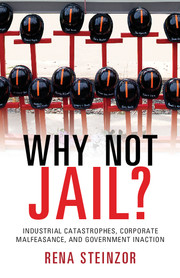Chapter 1 - Regulatory Dysfunction
Published online by Cambridge University Press: 05 December 2014
Summary
When a jury last week found a former suburban Chicago water department chief guilty of 11 charges related to mixing contaminated well water into a town’s drinking water supply, the verdict represented an important victory for the U.S. EPA’s criminal enforcement efforts.
EPA officials hope the potential five-year terms that could accompany each of the 11 counts will send a strong message to penny-pinching authorities who put their own interests ahead of the people they are supposed to serve. But the victory is also bigger than that.
Two months into sequestration – when across-the-board budget cuts and staffing reductions are taking a toll on EPA’s criminal enforcement efforts – reminding environmental wrongdoers that the agency can still pack a punch may be more important than ever.
Doug Parker, the director of the agency’s Criminal Investigation Division (CID), acknowledged last week that limitations on new hiring and furloughs mandated by sequestration are making the thin green line of EPA special agents even thinner.
“There are areas where there were boots on the ground where there are no longer boots on the ground,” Parker said.
He declined to be more specific about where the holes in coverage have developed for fear of alerting the bad guys.
John McArdle, GreenwireA Glass Half Full
Although regulation has fallen on hard times, its historic accomplishments are unimpeachable. Especially when compared to the dire straits of countries that have industrialized helter-skelter without such controls – China comes first to mind – the United States has achieved minor miracles in ameliorating the worst outcomes of economic development. In fact, until the implications of worldwide climate change became manifest a decade ago, modest self-satisfaction was appropriate. Without any question, traditional pollution problems persist, including ground level ozone (smog) in most major U.S. cities, dead zones in great waters from the Chesapeake Bay to the Gulf of Mexico, toxic chemical exposure in the workplace, endocrine disrupters in the food supply, and hazardous imports from countries that do not have regulatory controls. But grit is gone from the air, workplace and foodborne illness deaths are down dramatically, and consumer products, from cars to lawn mowers, are much safer. Each aspect of this progress is attributable directly to regulation or to the efforts made by regulated parties to get out ahead of it.
- Type
- Chapter
- Information
- Why Not Jail?Industrial Catastrophes, Corporate Malfeasance, and Government Inaction, pp. 15 - 39Publisher: Cambridge University PressPrint publication year: 2014



